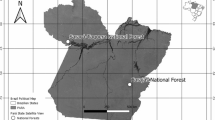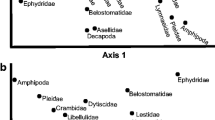Abstract
Sampling macroinvertebrate communities from natural snags (large woody debris) is difficult, particularly in southeastern Australia where the predominant river red gum snags are very large and heavy. This makes removal of natural snags impractical. The Snag Bag is a new method for sampling macroinvertebrates from natural snags. It consists of a 250 μm mesh bag with the sides closed by ‘Velcro’. When opened out, one side of the Snag Bag can be passed under the snag and the bag is then closed around the snag, before brushing the surface down to remove invertebrates. The Snag Bag is removed from the snag by loosening the ‘Velcro’ above the snag and closing it below, until the bag has almost been removed. The bag is then quickly pulled from the snag and out of the water. Snags with diameters of 5–30 cm at depths of up to about 50 cm can be sampled. The Snag Bag was trialed in two lowland rivers in south-eastern Australia. Repeated sampling showed that its efficiency was about 96%, comparing very favourably with other methods of collecting macroinvertebrates in streams. Its efficiency was not affected by current speed or the surface area sampled. A subsampling procedure was developed and tested, as whole samples were often extremely large. A proportion of the sample equivalent to a set surface area (0.05 m2) was sorted. If fewer than 300 animals were obtained, further known percentages of the original sample were processed fully, until 300 animals had been removed. The Snag Bag provided quantitative data that allowed discrimination between densities of invertebrates on snags at two different sites on the same river.
Similar content being viewed by others
References
Benke, A. C., T. C. Van Arsdall, Jr. & D. M. Gillespie, 1984. Invertebrate productivity in a subtropical blackwater river: the importance of habitat and life history. Ecol. Monogr. 54: 25–63.
Boulton, A. J. & L. N. Lloyd, 1991. Macroinvertebrate assemblages in floodplain habitats of the lower River Murray, South Australia. Regulated Rivers: Res. Mngmt. 6: 183–201.
Bournaud, M., B. Cellot, P. Richoux &A. Berrahou, 1996. Macroinvertebrate community structure and environmental characteristics along a large river: congruity of patterns for identification to species or family. J. n. am. Benthol. Soc. 15: 232–253.
Bournaud, M., H. Tachet, A. Berly & B. Cellot, 1998. Importance of microhabitat characteristics in the macrobenthos microdistribution of a large river reach. Ann. Limnol. 34: 83–98.
Brooks, S., 1994. An efficient and quantitative aquatic benthos sampler for use in diverse habitats with variable flow regimes. Hydrobiologia 281: 123–128.
Clarke K. R., 1993. Non-parametric multivariate analyses of changes in community structure. Aust. J. Ecol. 18: 117–143.
Clarke, K. R. & R. M. Warwick, 1994. Change in Marine Communities: an Approach to Statistical Analysis and Interpretation. Natural Environment Research Council, Plymouth Marine Laboratory, Plymouth, England.
Cogerina, L., B. Cellot & M. Bournaud, 1995. Microhabitat diversity and associated macroinvertebrates in aquatic banks of a large European river. Hydrobiologia 304: 103–115.
Delong, M. D., J. H. Thorp & K. H. Haag, 1993. A new device for sampling macroinvertebrates from woody debris (snags) in nearshore areas of aquatic systems. Am. Midl. Nat. 130: 413–417.
Elliott, J. M., 1977. Some Methods for the Statistical Analysis of samples of Benthic Invertebrates. Freshwater Biological Association Scientific Publication No. 25. FBA, Ambleside, England: 158 pp.
Elliott, J. M. & C. M. Drake, 1981. A comparative study of four dredges used for sampling benthic macroinvertebrates in rivers. Freshwat. Biol. 11: 245–261.
Growns, I. O., 1994. Efficiency estimates of a stream benthos suction sampler. Aust. J. mar. Freshwat. Res. 41: 621–626.
Humpesch, U. H. & J. M. Elliott, 1990. Methods of biological sampling in a large deep river – The Danube, Austria. Wass. Abwass., Suppl. 2/90; 83 pp.
Humphries, P., J. E. Growns, L. G. Serafini, J. H. Hawking, A. J. Chick & P. S. Lake, 1998. Macroinvertebrate sampling methods for lowland Australian rivers. Hydrobiologia 364: 209–218.
Humphries, P., P. E. Davies & M. E. Mulcahy, 1996. Macroinvertebrate assemblages of littoral habitats in theMacquarie and Mersey Rivers, Tasmania: implications for the management of regulated rivers. Regulated Rivers: Res. Mgmt. 12: 99–122.
Humphries, P. & P. S. Lake, 1996. Environmental flows in lowland rivers: experimental flow manipulation in the Campaspe River, Northern Victoria. In 23rd Hydrology and Water Symposium, Hobart, Australia, 21–24 May 1996. Australian Society of Engineers; 197–202.
Kerans, B. L., J. R. Karr & S. A. Ahlstedt, 1992. Aquatic invertebrate assemblages: spatial and temporal differences among sampling protocols. J. n. am. Benthol. Soc., 11: 377–390.
Lloyd, L. N., K. F. Walker & T. J. Hillman, 1991. Environmental significance of snags in the River Murray. Australian Water Research Advisory Council Completion Report, Project 85/45: 33 pp.
Marchant, R., 1989. A subsampler for samples of benthic invertebrates. Bulletin of the Australian Society for Limnology 12: 49–52.
Mordukai-Boltovskoi, Ph. D., 1979. The River Volga and its Life. Dr W. Junk bv Publishers, The Hague: 473 pp.
Muñoz, I. & N. Prat, 1994. Macroinvertebrate community in the lower Ebro river (NE Spain). Hydrobiologia 286: 65–78.
O'Connor, N. A., 1991a. The ecology of a northern Victorian lowland stream system. Ph.D. thesis, Monash University, Melbourne, Australia.
O'Connor, N. A., 1991b. The effects of habitat complexity on the macroinvertebrates colonising wood substrates in a lowland stream. Oecologia 85: 504–512.
Scholz, O. & P. I. Boon, 1993. Biofilms on submerged River Red Gum (Eucalyptus camaldulensis Dehnh. Myrtaceae) wood in billabongs: an analysis of bacterial assemblages using phospholipid profiles. Hydrobiologia 259: 169–178.
Schulze, D. J. & K. F. Walker, 1997. Riparian eucalypts and willows and their significance for aquatic invertebrates in the River Murray, South Australia. Regulated Rivers: Res. Mgmt. 13: 557–577.
Sheldon, F. & K. F. Walker, 1997. Changes in biofilms induced by flow regulation could explain extinctions of aquatic snails in the lower River Murray, Australia. Hydrobiologia 247: 97–108.
Sheldon, F. & K. F. Walker, 1998. Spatial distribution of littoral invertebrates in the lower Murray-Darling River system, Australia. Mar. Freshwat. Res. 49: 171–182.
Walsh, C. J., 1997. A multivariate method for determining optimal subsample size in the analysis of macroinvertebrate samples. Mar. Freshwat. Res. 47: 241–248
Zar, J. H., 1984. Biostatistical Analysis. 2nd edn. Prentice-Hall, Englewood Cliffs, New Jersey: 718 pp.
Zhadin, V. I. & S. V. Gerd, 1970. Fauna and Flora of the Rivers, Lakes and Reservoirs of the U.S.S.R.Keter Press, Jerusalem: 626 pp.
Author information
Authors and Affiliations
Rights and permissions
About this article
Cite this article
Growns, J., King, A. & Betts, F. The Snag Bag: a new method for sampling macroinvertebrate communities on large woody debris. Hydrobiologia 405, 67–77 (1999). https://doi.org/10.1023/A:1003705105879
Issue Date:
DOI: https://doi.org/10.1023/A:1003705105879




